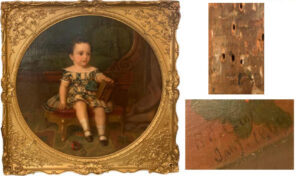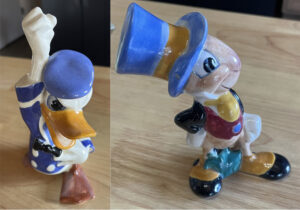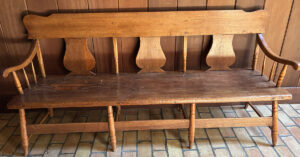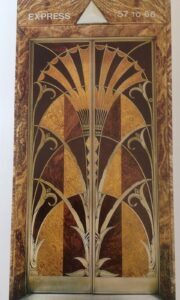Elizabeth Stewart's Blog, page 3
July 1, 2025
Dating Portrait and Gender By Clothing Style
 In many collections of American portraits of young children from the 1830-70s we ‘moderns’ cannot distinguish the genders of the sitters. SC sent me a little portrait of a child in a tartan dress: a case in point.
In many collections of American portraits of young children from the 1830-70s we ‘moderns’ cannot distinguish the genders of the sitters. SC sent me a little portrait of a child in a tartan dress: a case in point.
In 1850 the average American family size included six to nine children. Boys in the early to mid-19th century wore dresses handed down from sisters, typically termed frocks. These frocks were worn without either short or long pants underneath until a boy reached “breeching” age. A young boy reaches breeching age when he holds his own and doesn’t soil his breeches. Parents with both male and female children know boys are harder to potty train. Thus, “breeching” became a term used to describe the proper time to allow a young boy to wear breeches under a tunic. Younger toddlers in the 19th century didn’t wear gowns as they impaired freedom of movement, they wore tunic dresses, and diapers.
SC named her child portrait “Biddy’s Girl,” when in fact many elements point to it showing “Biddy’s Boy.” I date the portrait and gender by the clothing style. The little chap wears pantalettes, not knee pants or knickers. This was the fashion for both sexes until 1870 which a “breeched” boy wore a knee pant. By the 1870s boys often wore a stylized jacket and waist coat over a skirt, not a kilt, but a skirt with box pleats.
Hair styles also unisexBoys often wore long hair pulled back with a small bow. Later in the 19th century girls wore larger bows. The fabrics used were unisex. Both young boys and girls wore wool, fastened with hooks and eyes or buttons at the back. Garments didn’t differ for the genders until each of the sexes reached at least seven-years old. Publication of the book Little Lord Fauntleroy made European ringlets and velvet long trousered suits popular for young boys in the 1880s.
Originating in Britain, both genders wore tartans from 1850-70, but due to the popularity of sailor suits in Germany (1860-70) and Highland wear (kilt suits) in England boys dressed in sailor collars and tartan tunics. Both sexes worn sailor or Highland tunics until a child’s ninth year with either pantalets or tights underneath, preferably striped tights. The traditional Highland kilt was transformed into an American jacket and skirt in tartan for boys. By the 1880s large collars for boys with knee pants came in vogue, with large floppy bows at the collar. Still, up until the age of eight, a young boy wore what we now think of as a dress, in either cotton or wool, with bows.
Who’s the Artist?The owner of this little “Biddy-boy” portrait wants to know the artist, and if the artist sells for much. SC also wonders about the importance of this Americana artist. That’s not really the focal point of this little work, not all well painted. I found the signature almost indecipherable. It looks like A. R. Cu… or R.A. Cl… However, the artist of such a work, in this case, isn’t as important as the quality and style of child’s portraiture.
They called this style a “genre” painting when the 19th century viewer could identify the child’s nationality and class. Although we don’t “see” the gender nor the class or nationality clues today. This Biddy Boy child wears a finely made tartan dress. The child holds a little concertina, and he’s played with a ball (painting, dated 1869). The furniture in the painting is Renaissance Revival, purchased only by the affluent, and the carpet comes from “Turkey,” imported by the rich. The child’s face isn’t well-executed because the point of the painting is to place the child in his “class,” not to accurately portray the little boy.
I suspect the artist was Mary Anna Randolph Custis, the wife of Confederate General Robert E. Lee. An average painter of Virginian children, she sold her works to benefit the Confederacy. This style of children’s portraiture was ubiquitous in this era. The frame is also late 1860s.
The value, if by Custis Lee, is $1,000. The flavor of the interior furnishings in decidedly Southern American dating from the mid-19th century and places the child in his status as a well born Southern American gentrified child, likely a first born son.
The post Dating Portrait and Gender By Clothing Style appeared first on Elizabeth Appraisals.
June 29, 2025
The Earthquake That Built a City: Santa Barbara 1925 Earthquake, Then and Now
Retired Santa Barbara County Architect and architectural historian Robert L. Ooley, historian Neal Graffy, and Lobero historian Brett Hodges talk about The Earthquake That Built a City: Santa Barbara 1925 Earthquake, Then and Now at the Lobero Theatre on Sunday, June 29 at 5 pm.

The post The Earthquake That Built a City: Santa Barbara 1925 Earthquake, Then and Now appeared first on Elizabeth Appraisals.
June 24, 2025
Insurance For a Caucasian Soumak rug?
 In 3300 BCE, Otzi the iceman was murdered high on a mountain between Italy and Austria then buried in a glacier until 1991. At the time of the murder diverse ethnic groups settled the area between the Caspian Sea and the Black Sea (Georgia/Armenia/Azerbaijan), gradually leaving areas of the world becoming arid.
In 3300 BCE, Otzi the iceman was murdered high on a mountain between Italy and Austria then buried in a glacier until 1991. At the time of the murder diverse ethnic groups settled the area between the Caspian Sea and the Black Sea (Georgia/Armenia/Azerbaijan), gradually leaving areas of the world becoming arid.
Nomadic groups flowed through the Caucasus region. They camped near water or in the mountains near streams. The world began to change. Otzi might have foretold nomadic migrating people needing transportable durable textiles for bedding, bundling, shelter, and storage. In the early days in the Caucasus region, they made flat-woven, non-pile rugs for durability and longevity. If Otzi visited the region between Europe and Asia, a long walk since they discovered him in the mountainside between Italy and Austria, he’d have met the artists who originated C’s style of rug.
C received this rug as a gift. Should she insure it?In my book, No Thanks Mom: The Top Ten Objects Your Kids Do NOT Want, one of the top ten is Persian style rugs. The market puts a great deal of influence on value. Mid to late thirty year-olds don’t want eyebright colors and dizzying geometries of a Caucasian rug, although they come with a ancient, rich history. So C’s rug isn’t worth much in the market, even though photos show it’s pre-1925 and made with handwoven wool and natural, non-chemical, dyes. It SHOULD be worth more, and thirty years ago WAS worth more than today. So no, C, don’t insure it because it’s not worth more than $800 replacement value. Less if you use a standard of value called fair market value, the most common price paid in the relevant market.
Now that I delivered the bad news, let me cheer C up with the history of the ancient era her rug came from. The first patterns emerged in the 4th Millennium BCE (4000 BC to 3001 BC), the Bronze Age.
Caucasian Soumak Rug HistoryBefore the development of cuneiform writing, weavers practiced the pattern and method in C’s rug. Weaving, the potter’s wheel, and linen making developed in this era in the city states of Sumer, in the Caucasus, and Egypt. The world practiced animal husbandry and agriculture, as weavers in the Caucasus made rugs for individual, nomadic tribes. The world’s population doubled in the fourth millennium, over a thousand years. Patterns in their rugs echoed animals, nature, the cosmos, with each tribe making their own shapes.
While weavers wove, other parts of the world saw the invention of mathematics, astronomy, astrology, a kind of civil law, the sailboat, and the wheel. Also the potter’s wheel. In Iran, not far from the weavers in the Caucasus, the first pots were thrown. All over the world ethnic peoples practiced art for no reason except to picture their world in a symbolic, some say religious, fashion. As weavers created the first Caucasian rug, an artist in Spain painted the walls of their cave shelter with animals, shaman figures, and hand prints too. So although C’s rug isn’t a huge treasure in the market, it’s a reminder of the dawn of the applied arts.
Let’s Jump to the 19th century to the first quarter of the 20th century when C’s rug came off the loom. Russia took over Caucasus and Russian traders made certain regions in the Caucasus major exporters of this style of rug. Kuba, Shirvan, Kazak, Dagestan, Karabagh, used the old symbols executed in geometric forms in handspun wool and natural dyes. After 1925, this changed. The growing popularity of Caucasian flat weaves, highly colorful rugs meant mass production began with mechanical spinning of wool and chemical dyes, and less individualistic patterns and symbols.
C., a great difference exists between VALUE and WORTH.
The post Insurance For a Caucasian Soumak rug? appeared first on Elizabeth Appraisals.
June 22, 2025
25th Anniversary Yachty by Nature Concert
Captain Carl of Yachty by Nature and retiring Executive Director Greg Gorga talk about the Santa Barbara Maritime Museum 25th Anniversary Concert on Saturday, June 28.

The post 25th Anniversary Yachty by Nature Concert appeared first on Elizabeth Appraisals.
June 17, 2025
Disney Figurines: Prototypes or Production Pieces?
 R sent me two Disney ceramic figurines from the 1950s, both under six and a half inches. R’s parents sourced this dapper Jiminy Cricket and frustrated Donald Duck, with his fist raised in anger, from a Disney artist. Are they valuable prototypes or production pieces?
R sent me two Disney ceramic figurines from the 1950s, both under six and a half inches. R’s parents sourced this dapper Jiminy Cricket and frustrated Donald Duck, with his fist raised in anger, from a Disney artist. Are they valuable prototypes or production pieces?
The first of its kind is always most valued. The Donald figure made me ask: why is Donald so pissed off? Donald’s short tempered intense outbursts may be analyzed as Intermittent Explosive Disorder. Or on the other hand, the expectation of disappointment could be a cultural trait, common to both ducks and Danes. Yes you read that right!
Donald Brayton CompanyThe first company licensed to produce figures based on Disney movie characters, made the angry Donald figurine here in California. Brayton graduated from the Chicago Art Institute, moved to the artist’s colony of Laguna Beach, and built a kiln in his garage in 1927. Once out of the kiln, he painted his pottery, figural work and tableware, with distinctive colors: rose, strawberry, eggplant, jade, lettuce, chartreuse, gold, burnt orange. He didn’t have a shopfront. He put his wares outside in the front yard of his Tudor Style bungalow. By 1936 a new wife convinced him to create a factory with a showroom, design facilities, and high-end kilns on Pacific Coast Highway on a five acre plot. He employed, at the apex of the factory, a hundred and fifty artists, and won the contract for Disney ceramics.
Donald the DaneFailing to resist temptation, I read an article on Donald Duck’s anger problem by Kay Xander Mellish, on her blog “How to Live in Denmark.” She said Donald Duck is more popular with Danes than Mickey Mouse, the errant gentleman of Disney characters. Donald, whose name in Danish is Anders the duck, is the underdog. He doesn’t expect happy endings. So, he gets angry when what he expected, an insult, a bad outcome, too much work, or unwelcome demands, comes true. Mellish said the Danes identify with the underdog and identify with low expectations. Americans, who revere Mickey, revel in individualism and high expectations. Americans expect good things; Danes expect disappointment and are pleased when they’re wrong. At the heart of Donald Duck’s comedy turns, and Danish humor, are unfulfilled high expectations.
Polls suggest Denmark is the happiest country in the world. Danes are okay with dashed expectations, because for two-hundred years (1700-1900), due to loss of crops, people, and territory, Denmark was considered the poorest European country. Not anymore. When I last visited Copenhagen I found it hip, trendy, and rich. Like Donald Duck, Danes learned to turn repeated disappointments into humor or “self-irony.” The way Disney studios employed frustration to create the humorous side of Donald reflects Danes ability to make fun of themselves. In fact, the Danish tradition of ‘kvjebajer,’ the failure beer toast, shows that once a Dane fails, they celebrates failure, exhibiting that they’re not always the smartest person in every room. They buy all friends a drink to celebrate the fact that we’re all fallible HUMANS.
Disney’s Jiminy CricketThe Jiminy Cricket character is a production figurine from the 1940s modeled after the Disney film Pinocchio. Evan K Shaw created the expression of dapper dan confidence of the little cricket. The charming figure holds a brief case, an umbrella, and wears a jaunty top hat. Unlike the figures that came after this one, he does NOT have a green face, but a flesh colored visage. Shaw opened a kiln called “American Pottery” in Los Angeles and Disney awarded him a license to produce characters. A fire destroyed American Pottery in 1946, so Shaw bought Metlox Pottery in Manhattan Beach and continued to make Disney character.
The figure, as in the film, acted as Pinocchio’s conscience, as such, granted to him by the Blue Fairy. The Fairy endowed Jiminy “lord high keeper of the knowledge of right and wrong, counselor in moments of high temptation, and guide along the straight and narrow path.” We all need a Jiminy.
The value of Jiminy is $500 and Angry Donald is $600.
The post Disney Figurines: Prototypes or Production Pieces? appeared first on Elizabeth Appraisals.
June 15, 2025
Karen K. Lewis—Seven decades of color and curiosity
Painter Karen K Lewis talks about her exhibit, Seven Decades: The Art of Karen K Lewis, at the Ojai Valley Museum, June 19—August 3.
Watch Video

The post Karen K. Lewis—Seven decades of color and curiosity appeared first on Elizabeth Appraisals.
June 12, 2025
Damage Caused By Kids In Museums
 My two grandchildren are old enough to experience an art museum. Thus, I added a family membership to the wonderful Santa Barbara Museum of Art and one to the fabulous Santa Barbara Historical Museum. That very day I came across an article from a ‘business of the arts’ magazine describing damage caused by kids in museums and liability issues, and further, who pays for restoration. Some museums charge the parents, who are claimed as negligent, some museums don’t. Some insurers pay for damage from museum guests if accidental, some will not. I pulled together ten stories about this issue that I know will make you CRINGE.
My two grandchildren are old enough to experience an art museum. Thus, I added a family membership to the wonderful Santa Barbara Museum of Art and one to the fabulous Santa Barbara Historical Museum. That very day I came across an article from a ‘business of the arts’ magazine describing damage caused by kids in museums and liability issues, and further, who pays for restoration. Some museums charge the parents, who are claimed as negligent, some museums don’t. Some insurers pay for damage from museum guests if accidental, some will not. I pulled together ten stories about this issue that I know will make you CRINGE.
 In 2016, two parents filmed two kids pulling at a wall sculpture made of delicate glass. The kids climbed the platform. The sculpture, titled Angel is Waiting, appears in the shape of two glistening angel wings. One of the kids broke the bottom of one wing. The artist, Shelly Xue, turned this mishap into a noble (media garnering) gesture. She renamed the artwork Broken Angel, and installed a video from the surveillance cameras of the boys torturing her work of art directly next to the piece on the wall. The story reported in the important magazine Hyperallergic, and went viral.
In 2016, two parents filmed two kids pulling at a wall sculpture made of delicate glass. The kids climbed the platform. The sculpture, titled Angel is Waiting, appears in the shape of two glistening angel wings. One of the kids broke the bottom of one wing. The artist, Shelly Xue, turned this mishap into a noble (media garnering) gesture. She renamed the artwork Broken Angel, and installed a video from the surveillance cameras of the boys torturing her work of art directly next to the piece on the wall. The story reported in the important magazine Hyperallergic, and went viral.
Five years ago in the same museum of glass, two kids chased each other around the exhibition space. They collided with a display case holding 30,000 pieces of glass which comprised a scale model of Disneyland’s Enchanted Storybook Castle by the Arribus Brothers, Disney Crystal Artists. The boys apologized to museum staff! Bet they felt sorry when they say the Castle in pieces.
In another tragedy, a young boy became intrigued by a work of art created completely out of Legos. He pulled the six-foot sculpture down at a museum in Ningbo, China, one hour after the display opened to the public. The boy, who loved the Fox character from Disney’s Zootopia, apologized for destroying the $15,000 work. The artist accepted the apology. Another gracious move.
Trying to make a carving more eligible, two Norwegian kids attempted to dig a little deeper into the lines of a 5,000 year-old petroglyph on the island of Tro. The glyph, the oldest representation of “skiing,” became the theme of the design for the Olympics years before this destruction. Likewise, a young man on a trip to visit the monuments of Luxor in 2013 thought he’d remind people he “was there.” On the bottom of a 3,500 year-old hieroglyphic, he wrote “Ding Jinhao visited.”
Kids Climbing, hugging, and Pulling Museum staff who thought large ceramic and stone works of art were “safe” as mounted on their custom made plinths didn’t understand how fast a four year-old can climb. In Southend-on-Sea in England, a display of Roman artifacts contained a 800 year-old child’s coffin of sandstone. For a joke, a child climbed inside. He scared his parents to death, and broke off a chunk.
Museum staff who thought large ceramic and stone works of art were “safe” as mounted on their custom made plinths didn’t understand how fast a four year-old can climb. In Southend-on-Sea in England, a display of Roman artifacts contained a 800 year-old child’s coffin of sandstone. For a joke, a child climbed inside. He scared his parents to death, and broke off a chunk.
A young man attempted to climb an ancient stone Native American landmark in Oregon and broke his legs doing so. His friends achieved revenge by toppling the stone column to the ground, shattering the stone.
At Tomahawk Ridge in Overland Park, Kansas, a museum was rented out for a wedding. A young boy, in love with a low to the ground sculpture created in stone by Bill Lyons, Aphrodite di Kansas City, hugged it—and pulled it over. The museum hasn’t decided who will pay for the restoration. Love is love, and is rampant at a wedding. Can we blame the young man for falling in love with Aphrodite?
In 2024, Hecht Museum in Haifa, Israel featured huge ceramic jars used to store water and oil in the sixteenth century BCE. A four year-old wanted to see inside and pulled a massive jar close to his face. While he peered inside, it fell over and shattered. The jar, from the Middle Bronze Age, had sustained no damage for 3,500 years.
Safe from little ones on a wall? Three virtually irreplaceable works, all wall mounted, were damaged, all with exceeding high values.
Three virtually irreplaceable works, all wall mounted, were damaged, all with exceeding high values.
One, by contemporary modern master Donald Judd created a stylized ladder to nowhere: repeating ledges of blue glass traveling up a white wall to the ceiling, commissioned for the Tate Modern for $10 million. A young girl managed to climb the work like a fun ladder, knocked it off the wall in part, and then got scared at the top. Her parents explained to the guards that their child was “anti-establishment,” and clearly the piece was irresistible to kids. They blamed the museum for tempting their child.
In Taipei in 2015, a work of Baroque art (1600s) hung on the wall behind a rope barrier. A 12 year-old tripped, fell through the rope, and punched a hole through the work. The museum declared the event an accident and the parents are off the hook.
Finally, possibly the most valuable piece damaged by a child is a $56 million Rothko, No. 8: Orange Yellow Maroon, 1960 a large vertical wall mounted work, neither glazed nor varnished. Rothko intended the flat “color fields” to appear intense. At the Boijmans van Beuningen Museum, a young man couldn’t resist the color and attempted to “feel” it, scratching the paint layer.
I’m going to be careful when my grandkids visit….
The post Damage Caused By Kids In Museums appeared first on Elizabeth Appraisals.
June 10, 2025
Settee For A Great Dane
 My brother and sister-in-law live in a sophisticated New York high-rise near the Dakota. They’ve cared for a string of Great Danes, their favorite breed, suffering many elevator rides for pee breaks over the years. Lucy, their latest Dane, appeared in the Central Park romp scene in the 2024 movie The Friend. Lucy chases the central dog character, the Harlequin Dane Apollo. Yes, there’s a Dane Play Club in the Park! Look closely and see Lucy in the trailer for the movie starring Bill Murray and Naomi Watts. Watts plays a writer who adopts the Great Dane formerly belonging to Murray’s character, her friend and mentor. Poignant because the dog grieves for his lost master. My brother Paul and Melissa identified with adopting a huge animal in downtown Manhattan, and with the theme of abrupt endings.
My brother and sister-in-law live in a sophisticated New York high-rise near the Dakota. They’ve cared for a string of Great Danes, their favorite breed, suffering many elevator rides for pee breaks over the years. Lucy, their latest Dane, appeared in the Central Park romp scene in the 2024 movie The Friend. Lucy chases the central dog character, the Harlequin Dane Apollo. Yes, there’s a Dane Play Club in the Park! Look closely and see Lucy in the trailer for the movie starring Bill Murray and Naomi Watts. Watts plays a writer who adopts the Great Dane formerly belonging to Murray’s character, her friend and mentor. Poignant because the dog grieves for his lost master. My brother Paul and Melissa identified with adopting a huge animal in downtown Manhattan, and with the theme of abrupt endings.
Sadly, Lucy passed away after the release of the film. We all miss her 150 pounds and goofy expression. Like many treasured friends, the best ones sometimes have shorter life spans, and this is true of this noble breed, the Great Dane. Looking for a memorial for Lucy, I came across the Adopt a Bench program for New York’s Central Park Benches and Settees. This program, run by the Women’s Committee of the Central Park Conservancy, funds the Park’s 10,000 benches with 7,000 adopted benches for forty-two million visitors a year.
History of the SetteeFirst a run-down of the three important New York Central Park outdoor settees. The 1939 World’s Fair bench, with distinctive hoop armrests between each single seating area, shaped to echo the circular walking paths around the Park, painted Central Park Green. The straight planked slatted bench developed in 1858 when the Park opened its first ice skating rink, seen along the Mall. More modern, the concrete and wood bench. Kenneth Lynch and Sons, NYC bench makers, have reproduced all three styles since the 1920s.
The idea of multiple stations for multiple rear ends as one piece of seating furniture? That all began in the 10th century when a chest was one of the few pieces of furniture needed in a room. Chests held objects, people used them them as seats, also tables, and they became convenient for many moves. Built-in church monastic settees mixed with the design of the medieval household chest lead to the birth of the settee. These came in the form of a seat, bed, or chest with a hinged back that became a table or a bed. The armrests held candlesticks or tankards. Shelves under the settee houses drawers or footrests. The height of the backrest varied and sometimes continued to the floor. In fact, people often built the settee into a wall or corner and called it an Inglenook.
Settees Through the CenturiesBy the 15th century public houses or inns/taverns came into fashion for travelers needing accommodation so the wooden settee incorporated shelf rests for drinks. By the 17th century nailed-down leather added a little sitz-bones comfort. Chairmakers began to explore the settee as a household design based, not on the medieval chest, but on the Windsor chair with a canted back, shaped seats, and graceful arms. Country folk retained the tradition and the school master bench became popular in the 19th century. Then they became adopted into the historical lexicon of the Colonial Look in the early to mid-20th century.
Back in Deerfield, Illinois, in the 1960s Mother decorated the front room in ‘Colonial’ with lots of Ethan Allen furniture. We had a settee painted black with gold eagle stenciling.
Mrs. S sent me a shot of her settee in the style called American Sheraton transition to Classical. This New England settee from the first quarter of the 19th century in fruitwood, likely cherry or maple, comes with a shaped crest rail raised on wide lyre form splats. The settee has scrolled arms centering the single plank seat raised on eight turned legs joined by a box stretcher. She’s owned it for years and wondered about the value. In this market antiques are no longer as prized as they twenty-five years hence. These simple understated unfrilly plainspoken pieces of furniture are still desirable and command, for a good Pennsylvania settee, $800-$1,000.
The post Settee For A Great Dane appeared first on Elizabeth Appraisals.
June 6, 2025
1925 Santa Barbara Earthquake
Author and Pearl Chase Society President Cheri Rae talks about rebuilding Santa Barbara after the 1925 earthquake, and historian and author Betsy J. Green shares stories of survivors.
Watch Video

The post 1925 Santa Barbara Earthquake appeared first on Elizabeth Appraisals.
June 3, 2025
Vintage Graphic Design Work
 A gift the universe gives the right person is rare. Take Emma Howard, a talented local designer who gave me permission to use her name. She owns Studio 3 Hand Rendered Textiles and Surface Designs. While visiting her son she spotted a designer’s dream in front of a vacant house. Against the heap of old furniture leaned a vintage graphic design work, rendered by hand with old-fashioned tools of water based gouache, a paint brush, and a ruling pen, supported on a heavy paper board. The uneven edges of the design told Emma she found a hand-done work. No need for an artist to make perfectly finished edges because this template served as a basis for a side by side fabric design for a woven or printed fabric.
A gift the universe gives the right person is rare. Take Emma Howard, a talented local designer who gave me permission to use her name. She owns Studio 3 Hand Rendered Textiles and Surface Designs. While visiting her son she spotted a designer’s dream in front of a vacant house. Against the heap of old furniture leaned a vintage graphic design work, rendered by hand with old-fashioned tools of water based gouache, a paint brush, and a ruling pen, supported on a heavy paper board. The uneven edges of the design told Emma she found a hand-done work. No need for an artist to make perfectly finished edges because this template served as a basis for a side by side fabric design for a woven or printed fabric.
Emma asked my opinion on the age of the piece. It lost its frame and glazing on the street that day, but remains in remarkable condition. I know two ways to research date of creation. One is to research the technical developments in graphic design, or more to the point, the history of 3D designs from the pen to CAD for a computer.
The Other Way to Research this Work’s EraCompare it to other graphic designs in selected STYLES: a stylistic/artistic analysis. I researched a few select eras. One, the 1920-1930s when graphic design moved from Art Nouveau to Art Deco. The other era, 1950-1960, for graphic design influenced by Op Art.
Let’s take the technological approach. When did two and three-D software become predominant over hand rendered graphic design? Understandably an artist in 2025 creates a graphic design by hand, but the likelihood of a hand-rendered work created before such software is higher. Computer assisted 3D design didn’t becoming a future industry standard until the 1980s. Affordable personal computers helped in the early 1990s.
The first 2D software called “Sketchpad” launched in 1969. IBM released the first affordable PC in 1981. So the design Emma found either came from the Art Deco period OR the Op Art period. Both eras involved graphic designers who predominantly worked by hand.
Art Deco vs. Op Art Graphic DesignThe characteristics of Art Deco design, prevalent for a few years in the US 1920-30 include: bold, graphic shapes, strong lines, unusually rich colors with black or old metallic accents, glamour, luxury, zigzags, triangles, chevrons, streamlined patterns, clear order, symmetry. Those words sounded evocative for this period.
What characterizes Op Art design, mid-1950 to mid-1960s? Primary or slightly off primary (neon) vivid, eye-popping colors, repeating abstract patterns, clean geometric shapes and layouts, abstract repetitions. Which of these two stylistic eras best reflect the treasure that Emma found?
I compared Emma’s creation to my very favorite Deco design, the gorgeously rich elevator doors of the Chrysler building’s lobby in Manhattan. William Van Alen designed those doors in 1927-1930. They’re not PURE deco as he borrowed from the previous stylistic era (Nouveau) as we see by a hint of an exotic organic curvilinear line. The colors have rich deep tones, exotic wood, and gold leafing.
The colors of Emma’s treasure leads me to believe the stylistic period is likely NOT Deco, yellows and sky blues weren’t typical. Plus the paperboard looks in unusually good shape for a hundred year old board. It makes me lean towards the 1960s.
Importance of Fabric DesignIn the USA we’ve always considered design for fabrics important. Amazingly we see the cult of George Washington in 18th century textiles. His image on fabrics is ubiquitous, printed from copper plate or woven, with early Federal images of the eagle. One fabric shows “The Apotheosis of Ben Franklin,” a tribute to Franklin on his death in 1790, with George Washington leading his funeral cortege drawn by leopards. Franklin floats in a beaver fur cap. The Bauhaus (1920-1930) offered a degree in textile design, and geometric woven wool wall hanging produced in this era are artworks. Frank Lloyd Wright in 1950s designs were made by Schumacher Co and became iconic and highbrow purchases.
I place a value of $2,500 on Emma’s work of graphic art.
The post Vintage Graphic Design Work appeared first on Elizabeth Appraisals.
Elizabeth Stewart's Blog
- Elizabeth Stewart's profile
- 5 followers



